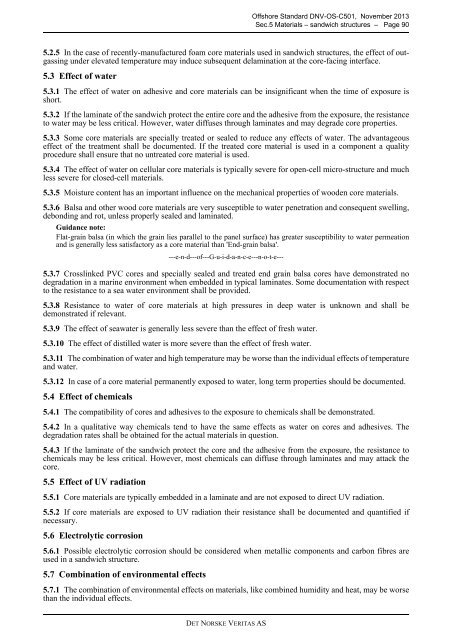OS-C501
Create successful ePaper yourself
Turn your PDF publications into a flip-book with our unique Google optimized e-Paper software.
Offshore Standard DNV-<strong>OS</strong>-<strong>C501</strong>, November 2013<br />
Sec.5 Materials – sandwich structures – Page 90<br />
5.2.5 In the case of recently-manufactured foam core materials used in sandwich structures, the effect of outgassing<br />
under elevated temperature may induce subsequent delamination at the core-facing interface.<br />
5.3 Effect of water<br />
5.3.1 The effect of water on adhesive and core materials can be insignificant when the time of exposure is<br />
short.<br />
5.3.2 If the laminate of the sandwich protect the entire core and the adhesive from the exposure, the resistance<br />
to water may be less critical. However, water diffuses through laminates and may degrade core properties.<br />
5.3.3 Some core materials are specially treated or sealed to reduce any effects of water. The advantageous<br />
effect of the treatment shall be documented. If the treated core material is used in a component a quality<br />
procedure shall ensure that no untreated core material is used.<br />
5.3.4 The effect of water on cellular core materials is typically severe for open-cell micro-structure and much<br />
less severe for closed-cell materials.<br />
5.3.5 Moisture content has an important influence on the mechanical properties of wooden core materials.<br />
5.3.6 Balsa and other wood core materials are very susceptible to water penetration and consequent swelling,<br />
debonding and rot, unless properly sealed and laminated.<br />
Guidance note:<br />
Flat-grain balsa (in which the grain lies parallel to the panel surface) has greater susceptibility to water permeation<br />
and is generally less satisfactory as a core material than 'End-grain balsa'.<br />
---e-n-d---of---G-u-i-d-a-n-c-e---n-o-t-e---<br />
5.3.7 Crosslinked PVC cores and specially sealed and treated end grain balsa cores have demonstrated no<br />
degradation in a marine environment when embedded in typical laminates. Some documentation with respect<br />
to the resistance to a sea water environment shall be provided.<br />
5.3.8 Resistance to water of core materials at high pressures in deep water is unknown and shall be<br />
demonstrated if relevant.<br />
5.3.9 The effect of seawater is generally less severe than the effect of fresh water.<br />
5.3.10 The effect of distilled water is more severe than the effect of fresh water.<br />
5.3.11 The combination of water and high temperature may be worse than the individual effects of temperature<br />
and water.<br />
5.3.12 In case of a core material permanently exposed to water, long term properties should be documented.<br />
5.4 Effect of chemicals<br />
5.4.1 The compatibility of cores and adhesives to the exposure to chemicals shall be demonstrated.<br />
5.4.2 In a qualitative way chemicals tend to have the same effects as water on cores and adhesives. The<br />
degradation rates shall be obtained for the actual materials in question.<br />
5.4.3 If the laminate of the sandwich protect the core and the adhesive from the exposure, the resistance to<br />
chemicals may be less critical. However, most chemicals can diffuse through laminates and may attack the<br />
core.<br />
5.5 Effect of UV radiation<br />
5.5.1 Core materials are typically embedded in a laminate and are not exposed to direct UV radiation.<br />
5.5.2 If core materials are exposed to UV radiation their resistance shall be documented and quantified if<br />
necessary.<br />
5.6 Electrolytic corrosion<br />
5.6.1 Possible electrolytic corrosion should be considered when metallic components and carbon fibres are<br />
used in a sandwich structure.<br />
5.7 Combination of environmental effects<br />
5.7.1 The combination of environmental effects on materials, like combined humidity and heat, may be worse<br />
than the individual effects.<br />
DET NORSKE VERITAS AS



